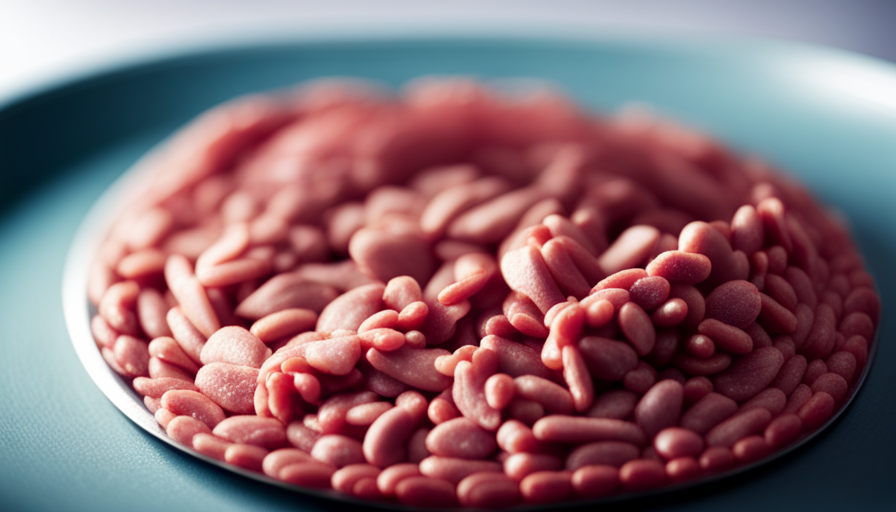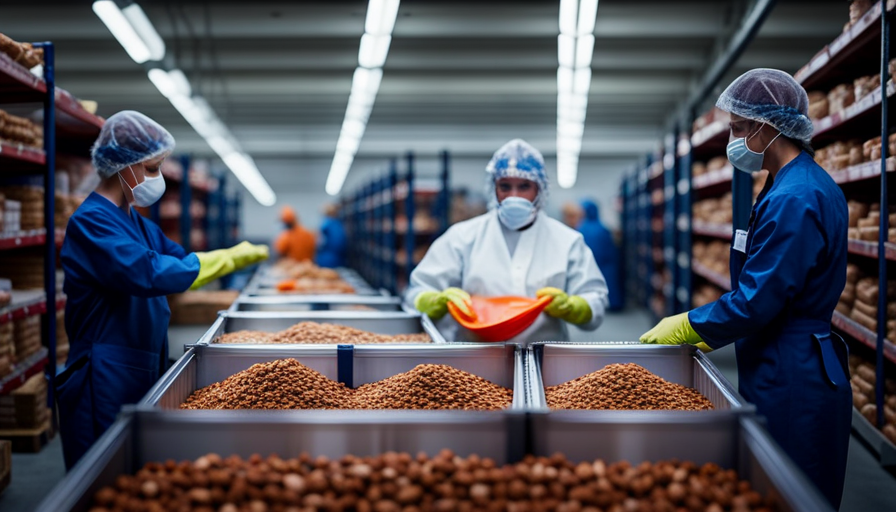Have you ever questioned why consuming raw meat can lead to food poisoning? It may be surprising that such a basic food item like meat can result in illness, however, the reality is that raw meat can contain harmful bacteria that can negatively impact our health.
In this article, I will delve into the science behind how raw meat can give you food poisoning and provide you with valuable knowledge on how to prevent it.
When we talk about raw meat, we’re talking about a potential breeding ground for bacteria such as Salmonella, E. coli, and Campylobacter. These bacteria can contaminate the meat during the butchering process or from the animal’s intestines. If not handled and cooked properly, these bacteria can multiply rapidly and cause severe illnesses when ingested.
To protect yourself and your loved ones from foodborne illnesses, it’s crucial to understand the risks associated with raw meat and practice proper handling and cooking techniques. By doing so, you can enjoy the deliciousness of meat without worrying about getting sick.
So, let’s dive into the world of raw meat and discover how to stay safe while enjoying our favorite meals.
Key Takeaways
- Raw meat can harbor harmful bacteria such as Salmonella, E. coli, Campylobacter, and Listeria.
- Cross-contamination can occur when raw meat comes into contact with other foods, utensils, or surfaces.
- Proper hygiene, including washing hands thoroughly, is essential when handling raw meat.
- Cooking meat to the appropriate internal temperature is crucial to kill any harmful bacteria present.
Understanding the Risks of Raw Meat
You may not realize it, but raw meat can actually pose a significant threat to your health by increasing the risk of food poisoning. Raw meat, such as beef, pork, poultry, and seafood, can contain harmful bacteria and parasites that can make you sick.
The main cause of food poisoning from raw meat is the presence of these pathogens, including Salmonella, E. coli, Campylobacter, and Listeria. These bacteria can contaminate the meat during slaughtering and processing, and if not cooked properly, they can survive and cause illness when ingested.
To prevent food poisoning from raw meat, it is essential to handle and cook it safely. One common cause of contamination is cross-contamination, which occurs when raw meat comes into contact with other foods, utensils, or surfaces. To prevent this, always keep raw meat separate from other foods, use separate cutting boards and utensils, and wash your hands thoroughly after handling raw meat.
Another important prevention method is cooking meat to the appropriate internal temperature. This kills any harmful bacteria present, ensuring that the meat is safe to eat.
Understanding the risks and taking necessary precautions when handling and cooking raw meat is crucial for preventing food poisoning.
Now, let’s explore the common bacteria found in raw meat and how they can cause illness.
Common Bacteria Found in Raw Meat
Discover the numerous bacteria commonly found in uncooked animal flesh that may lead to unwanted health issues.
Raw meat can be a breeding ground for various types of bacteria that have the potential to cause food poisoning. Salmonella is one of the most well-known bacteria associated with raw meat. It can cause symptoms such as diarrhea, abdominal pain, and fever.
Another common bacteria found in raw meat is Campylobacter. This bacterium is often present in poultry and can lead to gastrointestinal illness.
Escherichia coli (E. coli) is also a concern when it comes to raw meat consumption. This bacterium can cause severe abdominal cramps and bloody diarrhea.
Additionally, Listeria monocytogenes is a bacteria that can be found in raw meat and can cause a serious infection called listeriosis, which can be particularly dangerous for pregnant women, older adults, and individuals with weakened immune systems.
It is crucial to handle and store raw meat properly to prevent the growth and spread of these harmful bacteria.
Transitioning into the next section, proper handling and storage techniques are essential in minimizing the risk of foodborne illness.
Proper Handling and Storage of Raw Meat
Ensure that you handle and store uncooked animal flesh correctly to minimize the risk of harmful bacteria growth – have you ever considered the potential consequences of improper handling and storage techniques?
Proper hygiene is essential when dealing with raw meat. Wash your hands thoroughly with soap and warm water before and after handling it. This will help prevent the transfer of bacteria from the meat to other surfaces in your kitchen. Additionally, it’s crucial to keep raw meat separate from other foods to avoid cross-contamination. Use separate cutting boards and utensils for raw meat to prevent the spread of bacteria.
Safe thawing methods are also important in minimizing the risk of food poisoning. It’s best to thaw meat in the refrigerator, as this allows for a slow and controlled thawing process. If you need to thaw meat quickly, you can use the defrost function on your microwave. However, make sure to cook the meat immediately after thawing to prevent bacterial growth.
Proper handling and storage of raw meat are vital in reducing the risk of foodborne illnesses. By practicing good hygiene and using safe thawing methods, you can significantly minimize the chances of harmful bacteria multiplying. However, it’s important to remember that proper handling and storage are just the first steps in ensuring food safety. The next crucial step is cooking meat thoroughly to eliminate any remaining bacteria.
The Importance of Cooking Meat Thoroughly
Cooking meat thoroughly is essential to safeguarding your health and enjoying a delicious, safe meal. The importance of temperature control cannot be emphasized enough when it comes to cooking meat. Properly cooking meat at the right temperature kills harmful bacteria, such as Salmonella and E. coli, that can cause food poisoning. These bacteria can be present in raw meat, and if not eliminated through thorough cooking, they can pose serious health risks.
Undercooked meat is a major culprit behind foodborne illnesses. When meat is not cooked to the recommended internal temperature, bacteria present in the meat may survive and multiply. This can lead to various symptoms like nausea, vomiting, diarrhea, and abdominal pain. In severe cases, it can even result in hospitalization.
To ensure that meat is cooked thoroughly, it’s crucial to use a food thermometer to check the internal temperature. Different types of meat have different recommended internal temperatures. For example, poultry should be cooked to an internal temperature of 165°F (74°C), while ground meat should reach 160°F (71°C).
Cooking meat thoroughly is vital for your health. By following proper temperature guidelines, you can significantly reduce the risk of foodborne illnesses caused by undercooked meat.
In the next section, we’ll discuss the important topic of cross-contamination prevention.
Cross-Contamination Prevention
To prevent the transfer of harmful bacteria and keep your kitchen a safe environment, remember the adage ‘cleanliness is next to godliness’ when it comes to cross-contamination prevention. Cross-contamination occurs when bacteria from raw meat or its juices come into contact with other foods, utensils, or surfaces. This can lead to the spread of bacteria and increase the risk of food poisoning.
Here are three important steps to help prevent cross-contamination:
-
Separate: Always keep raw meat separate from other foods. Use different cutting boards, utensils, and plates for raw meat to avoid any contact with ready-to-eat foods. This will prevent the transfer of bacteria.
-
Clean: Thoroughly wash your hands, utensils, and surfaces with hot, soapy water before and after handling raw meat. This will help remove any bacteria that may be present.
-
Store: Store raw meat in leak-proof containers on the bottom shelf of the refrigerator to prevent any drips or spills onto other foods. This will minimize the risk of cross-contamination.
By following these steps, you can greatly reduce the risk of cross-contamination and ensure safe food handling practices in your kitchen. Recognizing the symptoms of food poisoning is crucial to seek timely medical attention if necessary.
Recognizing the Symptoms of Food Poisoning
When it comes to recognizing the symptoms of food poisoning, there are a few key points to keep in mind. First and foremost, nausea and vomiting are common signs that your body’s trying to rid itself of the harmful bacteria or toxins.
Additionally, diarrhea is often present and can be quite severe in some cases.
Lastly, abdominal pain and fever are also indicators of food poisoning, as your body’s immune system responds to the infection.
It’s important to pay attention to these symptoms and seek medical attention if they persist or worsen.
Nausea and Vomiting
Feeling queasy and throwing up can be an unpleasant consequence of consuming undercooked meat. Nausea and vomiting are common symptoms of food poisoning caused by ingesting harmful bacteria such as Salmonella or E. coli. When these bacteria enter our digestive system, they release toxins that irritate the lining of our stomach and intestines, leading to nausea.
To manage nausea, it’s important to stay hydrated and consume small, bland meals. Over-the-counter medications like anti-emetics can also provide relief. However, it’s crucial to seek medical attention if symptoms persist or worsen. In severe cases, hospitalization may be necessary for proper food poisoning treatment.
Now, let’s move on to discussing the next symptom: diarrhea.
Diarrhea
Experiencing loose bowel movements is a common bodily response that can occur after consuming improperly cooked food. Diarrhea is one of the ways our body tries to rid itself of harmful bacteria or viruses present in raw or undercooked meat. It is important to understand the causes of diarrhea and the available treatment options.
-
Bacterial infections: Consuming raw or undercooked meat can lead to bacterial infections such as Salmonella or E. coli, which can cause diarrhea.
-
Viral infections: Certain viruses, like norovirus or rotavirus, can also be transmitted through contaminated meat and result in diarrhea.
-
Parasitic infections: Parasites like Giardia or Cryptosporidium can be present in raw meat and cause diarrhea upon ingestion.
-
Toxin exposure: Some bacteria, like Clostridium perfringens, produce toxins that can cause diarrhea when consumed.
-
Treatment options for diarrhea include rehydration with electrolyte solutions, over-the-counter medications, and in severe cases, medical intervention.
Transitioning into the next section about ‘abdominal pain and fever,’ it is crucial to recognize other symptoms that may accompany diarrhea.
Abdominal Pain and Fever
Abdominal pain and fever often accompany diarrhea, signaling a potential infection or illness. When consuming raw meat contaminated with harmful bacteria, such as Salmonella or E. coli, these symptoms can occur due to the toxins produced by the bacteria in our digestive system.
Abdominal pain management can include over-the-counter pain relievers to alleviate discomfort, but it’s important to note that these medications don’t treat the underlying cause.
Fever treatment involves rest, hydration, and over-the-counter fever reducers like acetaminophen or ibuprofen. However, it’s crucial to seek medical attention if the abdominal pain becomes severe, if the fever is high or persistent, or if symptoms worsen or persist for more than a few days. This ensures proper diagnosis and treatment, as well as prevents any potential complications.
Transitioning into seeking medical attention for food poisoning, it’s important to understand the signs that indicate a need for professional care.
Seeking Medical Attention for Food Poisoning
Seek medical attention if you’re having symptoms like a wildfire, as raw meat can give you food poisoning. It’s important to seek medical treatment for food poisoning to ensure proper care and to prevent any complications.
While there are some home remedies that can help alleviate the symptoms, it’s always best to consult a healthcare professional for a proper diagnosis and treatment plan.
When seeking medical attention for food poisoning, here are three key things to keep in mind:
-
Describe your symptoms: Be as detailed as possible when explaining your symptoms to the healthcare provider. This will help them make an accurate diagnosis and determine the best course of treatment.
-
Follow their advice: The healthcare provider may recommend certain medications or procedures to help treat your food poisoning. It’s important to follow their advice and take any prescribed medications as directed.
-
Stay hydrated: One of the main concerns with food poisoning is dehydration. Drink plenty of fluids, such as water or electrolyte solutions, to replenish lost fluids and prevent further complications.
By seeking medical attention and following the advice of healthcare professionals, you can effectively manage food poisoning and minimize its impact.
With that in mind, let’s now explore ways to prevent foodborne illnesses in restaurants.
Preventing Foodborne Illnesses in Restaurants
When it comes to preventing foodborne illnesses in restaurants, there are a few key points to keep in mind.
First, it’s important to choose reliable establishments that have a strong track record of food safety. This can be done by checking online reviews and asking for recommendations from trusted sources.
Secondly, it’s crucial to check food safety ratings of the restaurant, which are often displayed prominently on their premises.
Lastly, don’t hesitate to ask about the restaurant’s food handling practices, such as how they store and prepare their ingredients, as this can give you insight into their commitment to food safety.
By being proactive and taking these steps, you can greatly reduce your risk of experiencing a foodborne illness.
Choosing Reliable Establishments
To ensure a safe dining experience, it’s crucial to pick trustworthy establishments. Reputation management and customer reviews play a vital role in making this decision. Before dining at a restaurant, I always check its reputation online. Customer reviews provide valuable insights into the establishment’s food safety practices and overall dining experience. It’s important to look for establishments with a consistent record of positive reviews and high ratings for cleanliness and food safety. To evoke emotion and help in decision-making, consider the following table:
| Establishment | Reputation | Customer Reviews |
|---|---|---|
| A | Excellent | 4.5 out of 5 |
| B | Good | 4.0 out of 5 |
| C | Average | 3.5 out of 5 |
| D | Poor | 2.0 out of 5 |
| E | Terrible | 1.5 out of 5 |
By choosing reputable establishments with positive customer reviews, you can greatly reduce the risk of foodborne illnesses. Now, let’s move on to the next section about checking food safety ratings.
Checking Food Safety Ratings
Checking food safety ratings can provide valuable information about an establishment’s adherence to proper food handling and preparation practices. Food safety inspections conducted by regulatory agencies evaluate various aspects of an establishment’s operations, including food storage, handling, preparation, and hygiene practices. These ratings give consumers an idea of the level of risk associated with dining at a particular establishment.
By checking food safety ratings, individuals can make informed decisions about where to eat, reducing their chances of contracting foodborne illnesses. It’s important to note that these ratings are based on a snapshot of the establishment’s practices on the day of inspection and may not reflect its current conditions. However, a consistently high rating indicates that the establishment takes food safety seriously and is committed to maintaining proper standards.
Transitioning into the next section, asking about food handling practices is another important step in ensuring a safe dining experience.
Asking About Food Handling Practices
Asking the staff about how they handle ingredients and maintain cleanliness in the kitchen can paint a vivid picture of their commitment to ensuring a safe and hygienic dining experience. Food safety guidelines play a vital role in preventing foodborne illnesses caused by raw meat.
It’s essential to inquire about their knowledge of proper cooking techniques, such as using a food thermometer to ensure the meat reaches the appropriate internal temperature. Additionally, asking about their practices for preventing cross-contamination, like separating raw meat from other ingredients and using separate cutting boards and utensils, can provide reassurance.
Maintaining proper hygiene, like frequent handwashing and sanitizing surfaces, is crucial as well. By understanding the staff’s commitment to these practices, you can be more confident in the safety of your meal.
Transitioning into the subsequent section about ‘tips for safe outdoor grilling,’ it’s important to consider these precautions when cooking meat outdoors.
Tips for Safe Outdoor Grilling
When it comes to safe outdoor grilling, there are three key points to keep in mind: preparing the grill, marinating and seasoning safely, and handling leftovers properly.
First, it’s important to thoroughly clean and preheat the grill to kill any bacteria that may be present.
Next, when marinating meat, always do so in the refrigerator to prevent the growth of harmful bacteria.
Finally, when it comes to leftovers, it’s crucial to refrigerate them within two hours of cooking to prevent foodborne illnesses.
Preparing the Grill
To ensure your grill is ready for cooking, first, brush off any debris and preheat it to create those sizzling grill marks on your meat. Grilling techniques play a crucial role in ensuring the safety and deliciousness of your food. One important aspect is monitoring the meat temperature. Using a meat thermometer can help you determine when your meat is cooked to the appropriate temperature, reducing the risk of foodborne illnesses. It is recommended to cook beef, pork, veal, and lamb to an internal temperature of 145°F (63°C), while poultry should reach 165°F (74°C). Incorporating a table to showcase the ideal meat temperatures for different types of meat can evoke a sense of confidence in the audience. By properly preparing your grill and monitoring the meat temperature, you can enjoy a safe and flavorful grilling experience. Now, let’s move on to marinating and seasoning safely.
Marinating and Seasoning Safely
Marinating and seasoning your food properly will enhance its flavors and create a mouthwatering experience. When it comes to marinating techniques, it’s important to remember that raw meat can harbor harmful bacteria such as Salmonella and E. coli.
To prevent cross contamination, always marinate meat in a covered container in the refrigerator, rather than on the counter. This helps to slow the growth of bacteria. Additionally, never reuse marinade that has come into contact with raw meat, as it can contain harmful pathogens. Instead, make extra marinade to use as a sauce after cooking.
By following these safe marinating practices, you can ensure that your food is both flavorful and safe to eat.
Now, let’s move on to the next section about handling leftovers properly, to further prevent foodborne illnesses.
Handling Leftovers Properly
Properly handling leftovers is essential for avoiding foodborne illnesses and keeping yourself healthy. Did you know that, according to a study, around 48 million Americans get sick from foodborne illnesses each year? To ensure the safety of your leftovers, here are three important techniques to follow:
-
Proper reheating techniques: When reheating leftovers, make sure the internal temperature reaches 165°F (74°C) to kill any harmful bacteria. Use a food thermometer to accurately measure the temperature.
-
Storing leftovers: Store leftovers in shallow, airtight containers in the refrigerator within two hours of cooking. This prevents the growth of bacteria. Label containers with the date to keep track of freshness and discard any leftovers that have been sitting for more than four days.
-
Avoid cross-contamination: Keep raw meat separate from other food items to prevent the spread of bacteria. Use separate cutting boards and utensils for raw meat and wash them thoroughly after use.
By following these proper handling techniques, you can reduce the risk of foodborne illnesses from leftovers.
Now, let’s delve into overall food safety practices for raw meat handling.
Overall Food Safety Practices for Raw Meat Handling
When handling raw meat, it’s important to follow good food safety practices to prevent the risk of food poisoning. Proper hygiene is crucial in minimizing the potential contamination of raw meat with harmful foodborne pathogens. This includes washing hands thoroughly with soap and water before and after handling raw meat, as well as using separate cutting boards and utensils for raw and cooked foods to avoid cross-contamination.
Additionally, storing raw meat at the proper temperature is essential. Keeping it refrigerated at temperatures below 40°F (4°C) slows down bacterial growth, while freezing it at 0°F (-18°C) can effectively kill most bacteria. It’s important to thaw frozen meat in the refrigerator or microwave, rather than at room temperature, to prevent the multiplication of bacteria.
Cooking raw meat to the appropriate internal temperature is another critical step in ensuring food safety. This kills any potential pathogens present in the meat. Using a food thermometer to check the internal temperature is recommended, with specific temperatures varying depending on the type of meat being cooked.
By practicing proper hygiene and following these overall food safety practices, the risk of food poisoning from handling raw meat can be significantly reduced. Being knowledgeable about these precautions is vital in keeping ourselves and our loved ones safe from foodborne illnesses.
Frequently Asked Questions
How can I tell if raw meat is contaminated with bacteria?
When it comes to detecting contamination in raw meat, there are a few key indicators to look out for. Firstly, trust your senses – if the meat has a strange odor or slimy texture, it’s best to steer clear.
Secondly, ensure proper safe handling techniques by washing your hands and utensils thoroughly after handling raw meat.
Lastly, use a food thermometer to ensure the meat reaches the appropriate internal temperature, killing any harmful bacteria.
Remember, being vigilant can save you from a stomachache!
Can I get food poisoning from eating raw fish or seafood?
Yes, it’s possible to get food poisoning from eating raw fish or seafood. It’s important to follow food safety guidelines for handling raw fish to minimize the risk of contamination. Common types of bacteria found in raw seafood include Salmonella, Vibrio, and Listeria. These bacteria can cause illnesses such as Salmonellosis, Vibrio infection, and Listeriosis. To ensure safety, it’s recommended to cook seafood thoroughly before consuming.
What are the long-term effects of food poisoning?
Long-term complications and health risks can arise from food poisoning. These can vary depending on the type of bacteria or toxin involved, as well as individual factors.
Common long-term effects include gastrointestinal issues such as chronic diarrhea, irritable bowel syndrome, and inflammatory bowel disease. Some cases can also lead to kidney problems, nerve damage, and even autoimmune disorders.
It’s important to seek medical attention and take necessary precautions to prevent foodborne illnesses and their potential long-term consequences.
Is it safe to eat raw meat if it’s been frozen?
Eating raw meat that’s been properly handled and frozen can be safe. However, caution must still be exercised. Just like navigating treacherous waters with a sturdy ship, the safety of eating raw meat lies in proper handling and preparation. Freezing meat at temperatures below 0°F (-18°C) can help kill certain pathogens. It’s crucial to thaw frozen meat in the refrigerator and cook it to the recommended internal temperature to ensure food safety.
Are there any specific precautions pregnant women should take when handling raw meat?
When it comes to handling raw meat during pregnancy, there are some important precautions to keep in mind. Firstly, always wash your hands thoroughly before and after touching raw meat to avoid any potential bacteria or contaminants.
Secondly, make sure to use separate cutting boards and utensils for raw meat to prevent cross-contamination.
Lastly, ensure that the meat is cooked thoroughly to kill any harmful bacteria that may be present. These simple precautions can help reduce the risk of foodborne illnesses during pregnancy.
Is it possible to completely eliminate the risk of food poisoning from consuming raw meat?
Consuming raw meat always poses a risk of food poisoning due to the presence of harmful bacteria. However, proper cooking methods such as grilling, boiling, or roasting play a crucial role in killing harmful bacteria in food and thus significantly reducing the risk of foodborne illness.
Conclusion
In conclusion, it’s crucial to handle and cook raw meat properly to prevent food poisoning and ensure food safety.
As I learned through personal experience, neglecting these precautions can have dire consequences. Just like a ticking time bomb, bacteria lurk in raw meat, waiting to cause havoc in our bodies.
With over 48 million cases of foodborne illnesses reported each year, it’s evident that we must take this issue seriously. By following proper handling and cooking techniques, we can protect ourselves and our loved ones from the dangers of food poisoning.
Stay informed, stay safe!










